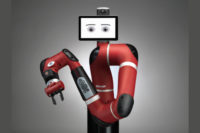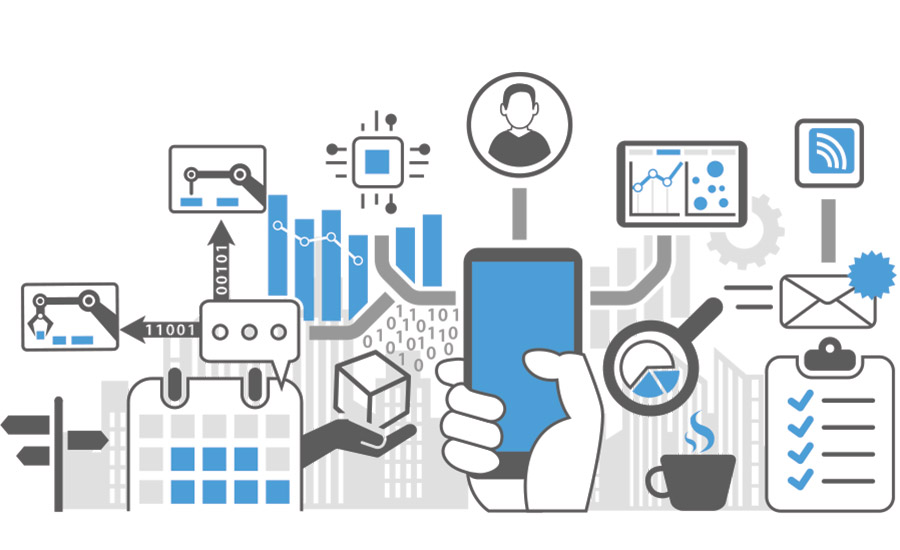Cover Story
Robotics and the smart factory
Smart machines and industry 4.0 accelerate productivity










Today’s manufacturing is different than the past – that is an obvious statement. What’s referred to as Industry 4.o and the smart factory is the wave of the future, and really the present. It is defined as the current trend of automation and data exchange in manufacturing technologies. It includes cyber-physical systems, the Internet of Things and cloud computing. Today’s robotics and automation on the packaging line include more sophisticated software that keep these processes in communication with each other and the line moving effortlessly.
The Internet of Things
The Internet of Things (IoT), Industry 4.0 and smart machines refer to the wave of connected machinery that “speaks” to one another for up-to-date information, feedback and monitoring, as well as increased productivity. Thanks to application of the IoT, 72% of manufacturers saw increases in productivity and 69% saw improved profitability in the past year, according to The MPI Internet of Things Study, sponsored by BDO (bdo.com). The study also states that half of plant production and equipment processes are already being managed via the IoT, and that number is set to climb. New controllers and robots are launching to increase accuracy and beef up productivity in plants.
The need for greater productivity
In response to the need for solutions that offer greater overall productivity, connectivity and flexibility, JLS (jlsautomation.com) offers a hygienic robotic packaging system that integrates motion, logic, safety and HMI into a single scalable platform. The new platform is available for both Talon® robotic pick and place systems and Osprey® robotic case packers. A leading edge industrial computing platform was integrated to offer superior motion control and a path to Industry 4.0 concepts of greater flexibility and IOTT connectivity. This versatile control system features a small electrical footprint, allows for simple system expandability, is easy to use and offers simplified remote diagnostics.
The systems are also hygienic with a stainless steel (IP69K rated) delta robot with higher payload capacity (up to 66 lbs.) as part of the next generation systems. Other sanitary features include standard open-frame design for easy access, inspection and maintenance, as well as sloped surfaces for easy runoff. Visit JLS Automation in booth #S-6325 at PACK EXPO Las Vegas this month to see live demonstrations of the next generation Talon robotic pick and place system and Osprey robotic case packers.
Collaborative robots are a sweeping trend due to their ease of use next to humans on the line, as well as their sophisticated programming that make them part of the team. Featuring power and force limiting technology, Yaskawa Motoman’s (motoman.com) new six-axis HC10 robot works safely with humans. Dual torque sensors in all joints constantly monitor force to quickly stop when the robot makes contact. It is designed to eliminate operator pinch points while through-arm utilities hide cabling and increase safety by reducing the risks of snagging or interference with other equipment.
Utilizing Easy Teach software, users can hand-guide the HC10 robot when teaching new program paths. This allows it to be quickly deployed or redeployed on demand, decreasing system downtime and increasing ROI.
The HC10 offers a 10-kg payload and 1,200mm reach and can perform a broad range of material handling, machine tending or light assembly tasks. The robot is controlled by Yaskawa’s new high-performance (and highly compact) YRC1000 controller that is built to a global standard and does not require a transformer for input voltages ranging from 380VAC to 480VAC. Visit Yaskawa at PACK EXPO in booth #C-4444.
Staying in control
The right controller can save time and money, and most are designed to be easier to use than ever before. Lenze Americas (lenze.com) announces the launch of the c250-S, a safety controller that enables engineers to program all of the machine’s safety needs using just one engineering tool based on the PLCopen standard. Integrating the c250-S into an automation system will make engineering easier, improve diagnostics, and reduce the number of interfaces and components. This saves time and money, and ultimately increases the machine’s availability and flexibility.
To date, Lenze has concentrated on drive-related safety functions. Now though, safety has been completely integrated into the system, enabling projects to be implemented faster because there are no longer differences in the software tools for drive technology and safety. This is particularly beneficial in the implementation of projects where machine operators need to take action within a machine’s danger zone. This uniformity also makes it possible, via EtherCAT, to display diagnostic messages in more detail, such as “supply voltage too low” instead of simply “error,” which can save time during commissioning or service. Lenze will be officially launching the c250-S at PACK EXPO in booth #S-6033.
For easier use of robots and automation in the manufacturing industry, FANUC (fanucamerica.com) recently launched its new R-30iB Plus controller, which features a new iPendant with an enhanced screen resolution and processing capability. The user interface, iHMI, has an icon-based screen which provides a familiar and easy-to-use experience with intuitive guides for setup and programming. It also includes tutorials from the main home, and with the help of the programming guide, even first-time robot users can create a program for a simple handling task and execute it in just 30 minutes. Easier usage also facilitates system setup and maintenance to improve efficiency.
Because it’s all about being easy for the user, for those more comfortable with the current interface, the new iPendant can easily revert to the previous version. Processing performance for both hardware and software has been improved in the R-30iB Plus, and the signal processing cycle has been shortened. Visit FANUC at PACK EXPO in booth #C-4800.
Click here to read about Universal Robots' case study regarding automated egg handling.
Robots and automation, including smart machines and controllers all work together to boost productivity, which can mean a boost in profits and accuracy. Industry 4.0 is aiding in this by ensuring constant communication and accountability for a new, smarter way of manufacturing.
|
So how does Industry 4.0 affect the sales & marketing side of the consumer packaged goods business? Kevin McGirl, president of sales-i, a sales analytics software provider, fills us in. McGirl: I think of Industry 4.0 as a two-sided phenomenon. One side emphasizes the efficiency of manufacturing: how technology is being used to decentralize decision-making and limit the need for human input – or rather, redirect it to where it’s most needed. This is possible because modern machines are better equipped than ever before to connect with and communicate with each other independently of any operator (if, indeed, an operator is needed at all). The other side focuses on the customer-facing, business end of manufacturing: the technology that empowers sales and marketing teams to replace inefficiencies with efficiencies. Whether CPGs see serious benefits in terms of sales and marketing is dependent on their speed of adoption. Competition in the packaging industry is fierce and unrelenting: being able to identify key accounts to contact, spot hidden opportunities in customer and prospect data, create personalized sales and marketing campaigns to attract and retain business, and gather up-to-date insight on the performance of your product lines is increasingly important, and technology makes it easier.” Now, you can know who’s buying what, who isn’t, and at what margin with a few clicks and keystrokes. For sales and marketing teams, Industry 4.0 is ultimately going to be about who seizes these opportunities – and who lags behind. PS: What opportunities are there within Industry 4.0 that will help CPGs grow their businesses? McGirl: Maintaining relationships across long, complex supply chains is becoming more difficult – vendors, distributors, partners, retailers and end-users together form an intricate ecosystem. It can be difficult for a CPG to satisfy every link in these chains, or even to know what’s happening and at which point. ERP (enterprise resource planning), CRM (customer relationship management), and BI (business intelligence) technology can help manage these relationships more effectively – ensuring that every step of the supply chain is updated with delivery times, logistics, customer expectations, transactions, and any other information that’s required in a timely fashion. Kevin McGirl is president of sales-i (sales-i.com), a sales analytics software provider for manufacturers, distributors and wholesalers, including those operating in the packaging industry. The software allows sales professionals to clearly identify and target high-quality sales opportunities within their current customer base. Equipped with customer buying behavior alerts, salespeople can make insightful, personalized, quick business decisions, realizing repeat sales, reduced customer attrition and maximized profit margins as a result. |
Looking for a reprint of this article?
From high-res PDFs to custom plaques, order your copy today!












